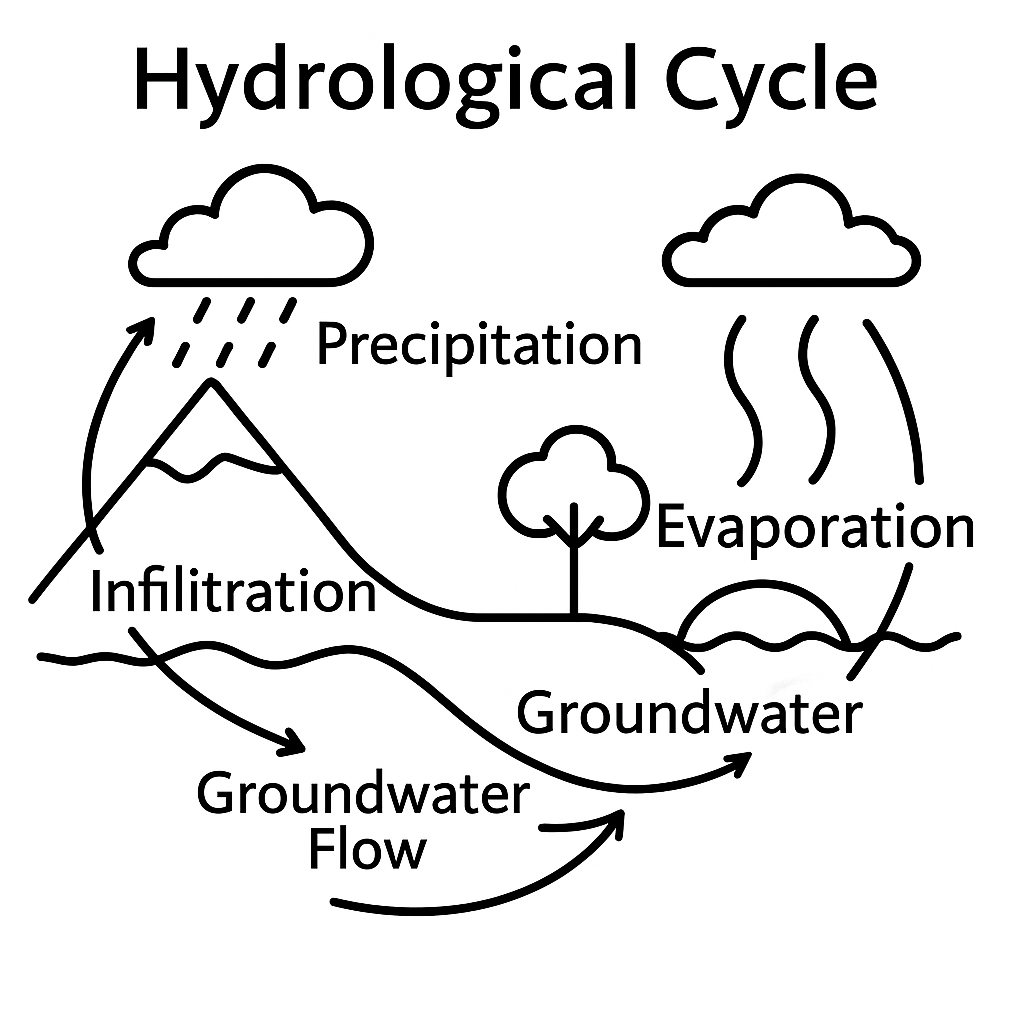The hydrological cycle, also known as the water cycle, is a fundamental process that is essential to life on Earth. The cycle is the continuous movement of water from the earth’s surface to the atmosphere and back to the surface through precipitation and evaporation. The hydrological cycle is responsible for the distribution of water on the planet, the regulation of temperatures, and the maintenance of the water balance in the atmosphere.

Table of Contents
Stages of the Hydrological Cycle
The hydrological cycle can be divided into four main stages: precipitation, evaporation, infiltration, and run-off.
- Precipitation: Precipitation is the release of water in the form of rain, snow, sleet, or hail from the atmosphere to the earth’s surface. This stage is initiated by the condensation of water vapor in the atmosphere, which forms clouds. When the clouds become too heavy, the water droplets combine and fall to the earth as precipitation.
- Evaporation: Evaporation is the process by which water changes from its liquid state to its gaseous state and returns to the atmosphere. This stage occurs when the sun’s energy warms the water on the earth’s surface, causing it to evaporate and form water vapor. The water vapor rises and cools, forming clouds and starting the precipitation process again.
- Infiltration: Infiltration is the process by which water from precipitation enters the soil and becomes part of the groundwater. The amount of water that infiltrates the soil depends on factors such as the type of soil, the amount of vegetation, and the intensity of the precipitation. Infiltration is an important part of the hydrological cycle as it replenishes groundwater reserves, which are essential for human and environmental use.
- Run-off: Run-off is the flow of water over the earth’s surface and into streams, rivers, lakes, and oceans. This stage occurs when the water that does not infiltrate the soil runs off into surface water bodies. Run-off is also influenced by factors such as the slope of the land, the type of vegetation, and the intensity of the precipitation.
Role of Human Activities
Human activities have a significant impact on the hydrological cycle. Land use changes, such as deforestation and urbanization, can alter the balance of the water cycle by reducing the amount of vegetation that is available to absorb water and increasing the amount of impervious surfaces, such as roads and buildings, that prevent water from infiltrating the soil. This can lead to increased run-off and the creation of flash floods in urban areas.
Another impact of human activities is the alteration of river systems. Human activities, such as dam construction and the extraction of groundwater, can change the natural flow of water in rivers and disrupt the hydrological cycle. This can lead to changes in water availability and quality, which can have negative effects on human and environmental systems.
The use of irrigation in agriculture can also have a significant impact on the hydrological cycle. Irrigation can lead to the depletion of groundwater reserves and the reduction of water availability for other uses. In addition, irrigation can cause changes in the salinity and mineral content of the soil, which can have negative effects on crops and the environment.
Managing the Hydrological Cycle
Understanding and managing the hydrological cycle is essential for ensuring a sustainable water supply for human and environmental use. Effective
Water management practices, such as rainwater harvesting, conservation, and the use of drought-resistant crops, can help to ensure the availability of water for future generations. In addition, the proper management of the hydrological cycle can help to reduce the impact of natural disasters, such as floods and droughts, by reducing the amount of water that is lost to run-off and by improving the ability of the soil to absorb and retain water.
Water management can also help to improve water quality. For example, by reducing the amount of pollutants that are released into the environment, such as chemicals and waste, the water cycle can be protected, and the quality of water can be improved. In addition, the proper management of groundwater resources can help to ensure that they are available for future use and that they are not depleted.
Another benefit of understanding and managing the hydrological cycle is the ability to improve agricultural production. By ensuring the availability of water for irrigation and by reducing the impact of droughts, farmers can produce more crops and improve their livelihoods. In addition, by reducing the amount of water that is lost to run-off, farmers can conserve water and reduce the amount of water that is required for irrigation.
Conclusion
The hydrological cycle is a complex and dynamic process that plays a critical role in maintaining the balance of life on Earth. Understanding and managing the water cycle is essential for ensuring the availability of water for human and environmental use, reducing the impact of natural disasters, and improving water quality. By implementing effective water management practices, we can ensure that the hydrological cycle continues to provide the essential resources that are needed for life on Earth.